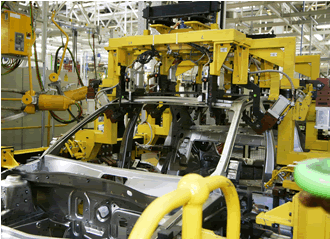Powering the Industrial Internet of Things
Industries that require precision placement of components, such as automation, are benefiting from the growing number of deployed sensors and from the insights generated from the data they produce. But is the IIoT factory floor ready to handle the potential security risk?
 In manufacturing, early identification of process or product variance allows early correction, which reduces defects and increases efficiency. The Industrial Internet of Things (IIoT) enables a new way of targeting and reducing variability. Processes that require variable elements, such as temperature, pressure, and viscosity, or industries that require precision placement of components, such as automation, are benefiting from the growing number of deployed sensors and from the insights generated from the data they produce.
In manufacturing, early identification of process or product variance allows early correction, which reduces defects and increases efficiency. The Industrial Internet of Things (IIoT) enables a new way of targeting and reducing variability. Processes that require variable elements, such as temperature, pressure, and viscosity, or industries that require precision placement of components, such as automation, are benefiting from the growing number of deployed sensors and from the insights generated from the data they produce.
For example:
- Commercial transportation firms are using streaming sensor data from vehicles to identify potential breakdowns and perform preventive and predictive maintenance.
- Agricultural and mining companies are using sensor networks to coordinate the movement of equipment in the field, develop driverless fleets, improve fleet maintenance, and enhance safety.
- Automotive manufacturers are using onboard diagnostic data that can detect equipment failure, safety risks, and defects.
- For oil and gas producers and refiners, downtime is a major issue and the industry is using more and more sensors, networks, and analytics to generate predictive insight into equipment performance and predictive maintenance.
IIoT Evolves
As the examples above show, the IIoT is rapidly evolving from a concept to reality, and it is driving growth in ultra-low-power (ULP) wireless technology, which will ensure ultra-efficient data communications in the internetworking of sensor arrays and other devices. There will be several contenders for the ULP wireless protocol of choice, but what the leading technology will be is not yet clear.
Wireless platforms that enable the IIoT are based on standard and custom RF coaxial connectors, cable assemblies, and antennas. Also, unique solutions are required for the IIoT, such as communication technologies that include cellular, UMTS, Wi-Fi, Bluetooth, GPS, and more.
While many of the technologies powering the IIoT are not fully mature, sensors have been available for a number of years and have achieved a degree of maturity. The two types of sensors mentioned above, temperature and pressure sensors, are now incorporated in an enormous number of devices. Accelerometers are now a staple feature of mobile devices, allowing the display to “flip” and change with the orientation of the screen. In addition, magnetometers supply electronic compass functions and gyroscopes stabilize movement – in camera lenses for example.
Multi-functional Fusion Sensors
Many of these standalone functions are now being incorporated in multi-functional or “fusion” sensors, and we could see this space and cost-saving trend accelerate. These fusion centers will be used in both the overall Internet of Things (IoT) and the IIoT.
Also, sensors will be getting help from new industrial protocols, such as IO-Link. These protocols will allow sensors to get smarter, provide more sensing capabilities, and enable internal diagnostics and maintenance information sharing – all while keeping interconnection costs low. The infrastructures installed on the factory floor or in other industrial applications are transitioning from proprietary and serial Fieldbus into newer Ethernet-based networks such as PROFINET or EtherNet/IP to accommodate the higher data volumes required by these new capabilities. The infrastructure itself is migrating from passive media to active control and monitoring in order to decentralize data management and increase data availability.
Technology Convergence
While these protocols are vital, it is important to keep in mind that the IIoT is a vision made possible by technology convergence. A key aspect of the convergence process has been the development of a new generation of sensor chips, such as temperature and pressure sensors. A second factor is the arrival of IPv6 addressing, which enables an almost limitless number of people and devices to communicate via the Internet. Third, we have seen the development of several competing protocols for ultra-low-power (ULP) wireless connectivity, which enables sensor-based networks to consume only a small amount of power.
Technologies such as the ones described above are developing and growing rapidly in the IIoT and other areas of the IoT, allowing the development of nearly endless new applications and efficiency enhancements. They will be drivers of significant innovation opportunities. However, IIoT deployments are still facing skepticism from traditional mindsets and there are concerns about security. These issues will have to be addressed before industrial devices and machines on the plant floor are opened to the Internet and allowed to fully benefit from the potential of these new technologies.
Contributed by Thierry Bieber, business development manager, Molex.
Visit the Molex Industrial Communication Competence Center
Recently published:
[related_posts limit=”10″]




